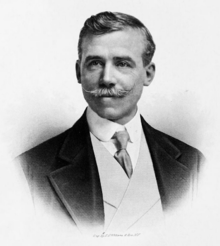Alexander Winton
Alexander Winton | |
|---|---|
 Alexander Winton | |
| Born | June 20, 1860 |
| Died | June 21, 1932 (aged 72) |
| Nationality | Scottish, American |
| Occupation(s) | Inventor and manufacturer |
| Known for | Winton Motor Carriage Company |
| Awards | Inducted into the National Inventors Hall of Fame |
| Signature | |
Alexander Winton (June 20, 1860 – June 21, 1932) was a Scottish-American bicycle, automobile and diesel engine designer and inventor. He also was an early automobile racer.
Life
Winton was born in Grangemouth, Scotland. His father (also Alexander) was a marine engineer, and young Alexander followed in his father's profession. He emigrated to the United States in 1879. For three years he worked at Delameter Iron Works, and for two years thereafter as a marine engineer on ocean vessels.[1]

In 1891, he founded Winton Bicycle Co., and in 1897 he founded the Winton Motor Carriage Company. His cars were custom made; in 1898 he sold a car for $1000.[2] In 1901, Henry Ford defeated him at a race at Grosse Pointe, Michigan.[3]
When he first started manufacturing cars, he wanted to be able to ship them directly to customers without putting any miles onto the product. He therefore developed a car hauler for use by his company, but soon was selling these car haulers to other manufacturers. This is the first instance of a semi-trailer truck product.[4]
The Winton Motor Carriage Company grew rapidly after the turn of the 20th century. In 1902 three buildings were built, and four more were added in 1903. The company employed 1200 workers in 1903.[5]
Winton was an important member of Association of Licensed Automobile Manufacturer (ALAM), an organization originally formed to challenge the litigation of the fledgling automobile industry by George B. Selden and the Electric Vehicle Company.
Winton was a prolific inventor, with over 100 patents in the field of motor cars and engines. He also had several important bicycle inventions. He was known for allowing free use of his patents when a question of safety was involved.[3]
Racing career

Winton was a pioneer in recognizing that racing was a primary means to promote his automobile business, both because of the public attention these races garnered as well as the focus on technical innovation. One of his first famous races was against Henry Ford, which he lost in 1901. In 1902 he built the first of three custom race cars, all three of which he called the 'Bullet'. Bullet No. 1 was the first car to win a sanctioned race at Daytona Beach, Florida. Bullet No. 2 was built for the Gordon Bennett Cup in Ireland in 1903. It was one of the first 8-cylinder automobiles ever built. It suffered mechanical difficulties and did not complete the race, although after being brought back to the United States Barney Oldfield drove it to a near-record 80 miles per hour (130 km/h) at Daytona. Winton retired from racing, but built a Bullet No. 3 which Oldfield raced around the United States in his famous career.[6]
Family
He married Jeanie Muir McGlashan (died 1903) in 1883; they had six children: Helen, James, Agnes, Jeanie, Cathrine, and Alexander.[5] He married LaBelle McGlashan (died 1924) in 1906; they had two children: LaBelle and Clarice. He married Marion Campbell in 1927 and divorced in 1930; and in 1930, he married Mary Ellen Avery.[7]
Legacy
He was inducted into the Automotive Hall of Fame in 2005,[8] and National Inventors Hall of Fame in 2006.[2]
The Winton Place Condominium in Lakewood, Ohio, was built in 1962 on the site of his former mansion.[9]
References
- ^ History of Cleveland. The Lewis Publishing Company. p. 439. Retrieved February 9, 2016.
- ^ a b "Alexander Winton". National Inventors Hall of Fame. Archived from the original on March 3, 2016. Retrieved February 17, 2016.
- ^ a b "Famous But Forgotten - Home". Wintonhistory.com. Retrieved February 19, 2016.
- ^ "The History of Semi Trailer Trucks". Great Western Transportation. Retrieved February 17, 2016.
- ^ a b Derby, George; White, James Terry (1904). The National cyclopaedia of American biography. New York: J.T. White. pp. 107–108. Retrieved February 19, 2016.
- ^ "Winton 'Bullet' No. 2, 1903". Smithsonian Institution. Archived from the original on 2016-03-03. Retrieved February 18, 2016.
- ^ "Encyclopedia of Cleveland History:WINTON, ALEXANDER". Ech.case.edu. Retrieved 2014-03-23.
- ^ "Alexander Winton". Automotive Hall of Fame. Archived from the original on 2016-03-03. Retrieved February 21, 2016.
- ^ "History of Winton Place Condominium". Archived from the original on March 2, 2016. Retrieved February 19, 2016.
Sources
- Thomas F. Saal, Bernard J. Golias Famous But Forgotten: The Story of Alexander Winton, Automotive Pioneer and Industrialist, Golias Pub., 1997, ISBN 9780965378512
